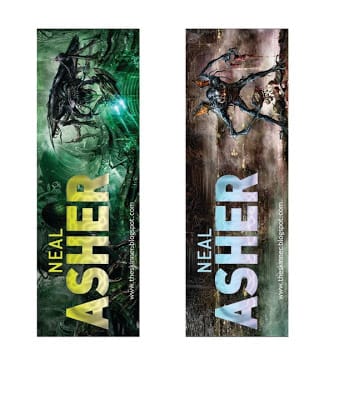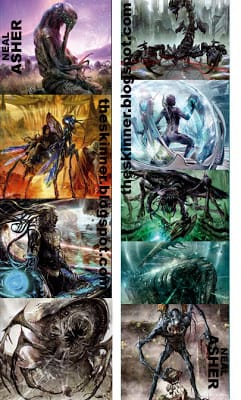Sometimes I feel optimistic and think the human race has a future. Then I catch a glimpse of something like X-factor, I’m a Celebrity, or Strictly Come Dancing and think ‘bread and circuses’ and realize there’s no hope at all.
Tag: Bits
Worlds Without End
Another SFF site I haven’t come across before. The guy running it is also one of the contenders in this bookmarks competition: Worlds Without End. It’s quite odd to look at biographical bit beside my photo and see that the ‘Died’ section is ready to be filled in.
Book Marks Competition
Right, the book marks competition is on. I want someone to design me book marks, using Jon Sullivan cover pictures and ensuring my blog address appears on them. The top three best designs get signed copies of any of my books they don’t have (though not a specific version of said book and excluding the ones they’ve won if first or second). The top two get the spatterjay series, whilst the winner also gets the Cormac series (both of these with the new covers).
Incidentally, I’ll be printing up and using the winners versions to hand over to book shops or people who might turn up at any signing I might do, so if you have a problem with that, don’t send anything.
You can email your efforts to me at ndotasheratvirgindotnet put a link in comments here or go find me on FaceBook, which isn’t difficult. And just to show you what you’re up against, here’s some first from Andy Plumbly and second from Brent Wise.
New Scientist Snippet.
A gene linked with sociality and novelty-seeking may make people more liberal in outlook, but only if they had plenty of friends during adolescence. The gene, DRD4-7R makes a dopamine receptor and was identified from DNA samples and a survey of 2547 adolescents.
It’s this kind of dross in New Scientist that sets my teeth gnashing. Admittedly it was taken from ‘The Journal of Politics’ and is little but a snippet, but that it appears in NS tells you something about the underlying mind set.
The words ‘linked with’ immediately remind me of the now famous words of Al Gore in his film when he informed us that ice core data shows a ‘correlation’ between CO2 rises and temperature rises, and then neglected to mention that the ice cores showed CO2 rising approximately 800 years after the temperature rise. How, precisely, is a gene that makes a dopamine receptor ‘linked with sociality and novelty-seeking’?
The next weasel word is ‘may’, as this gene ‘may make people more liberal in outlook’. Now what definition of ‘liberal’ are we talking about: the adjective in the dictionary, or espousing present day liberal views and politics, which tend to bear no relation to the aforementioned adjective? What exactly is being said here?
Then we get the bit about the necessity for having friends in adolescence for this gene to express its liberalism. Of course the implication here is that if you are ‘liberal’ you are probably sociable, novelty-seeking and not a Billy-no-mates. If you’re not ‘liberal’ you’re probably a sad fuck who had no friends when you were younger.
All this comes from a survey and DNA sampling of 2574 adolescents. So, how many of these adolescents did not have this gene? How many of them really ‘fessed up to having no friends? How did you establish any link at all between this particular scrap of DNA and the traits mentioned? And since when did opinion become science? Karl Popper must be revolving in his grave.
Art and Stuff
Cannabis Factory
Just posting this here because this is our local town, in fact Caroline used to work nearby this building at one time. I snaffled this from the Essex Police site. But then, this is not as close as the big cannabis greenhouse discovered in our village. Seems to be a common criminal occupation in Essex and, when in a Dengie 100 pub you mustn’t ask why you saw an aeroplane landing without lights on a local field. But it’s a crying shame that they’re destroying all this. They should legalize it and tax it. We need the money.
More than 8000 plants with an estimated street value of £2 million were discovered during a raid on an industrial unit in Heybridge near Maldon on Tuesday, November 9.
Nine purpose built rooms housing 280kg of skunk plants in various stages of growth and a sophisticated set up of lighting and hydropnic equipment were uncovered at a former print works in Hall Road.
Officers estimate the factory will have cost in the region of £250,000 to set up and may have been involved in supplying drugs across the UK and possibly abroad.
The factory also included its own electrical substation which had been illegally linked directly into local mains power supplies.
It is the largest ever discovered in Essex and is thought to be one of the biggest ever uncovered across the UK.
Thinking about Rocks
Printers
I’ve finally given up on the ink jet printer. These things are fine if you’re using them steadily, but if you’re living in two countries and therefore leaving your printer alone for seven months, it ain’t so good. I tried the technique of sealing the cartridges in a plastic bag, but they’ve dried up. Time I think to put away the bottles of ink and the syringe, and time to stop having to bleach ink off my fingers.
The best printer I ever had was an Oki monochrome laser, zero problems with it until the image drum reached the end of its long life. But I wanted colour and, last I recollected, colour laser printers were bloody expensive. Not the case now, so I’ve ordered a Samsung CLP-325 colour laser printer.
The First World War from Above
In total 21 mines were laid but two of them were not used, and the British then lost their location. One of them was detonated in 1955 by a lightning strike on a nearby pylon, but wrecking the surrounding area but killing only one cow, whilst the other still hasn’t been found.
As well as the aerial footage, some of the usual black-and-white film was shown in this: the guns firing, the men going over the top and a particular clip of a soldier carrying his wounded comrade out of a trench. All of these were immediately familiar since, before we came back to Britain, our TV viewing over a few days consisted entirely of The Great War. This series was first broadcast in 1964, narrated by Michael Redgrave, and is still well worth watching. Really, if you haven’t seen it, I suggest you do.
Update: I stand corrected. It was a total of 450 tons of explosives distributed to make 19 (or quite possible 21) mines under the German lines. This means they weight in at between 20 and 25 tons each and, as I noted in comments, was enough to shake the teacups in Downing Street. Then again, all of them went off within seconds of each other. Anyway, this brings me to the conclusion that a half kilotonne explosion would be enough to excavate Hanningfield reservoir, not the village duck pond.
Good Reads
While surfing the Internet I just came across this at goodreads. All very gratifying with a star rating about the same as Amazon but divided over more reviews. I seem to weigh in at about four stars generally.





